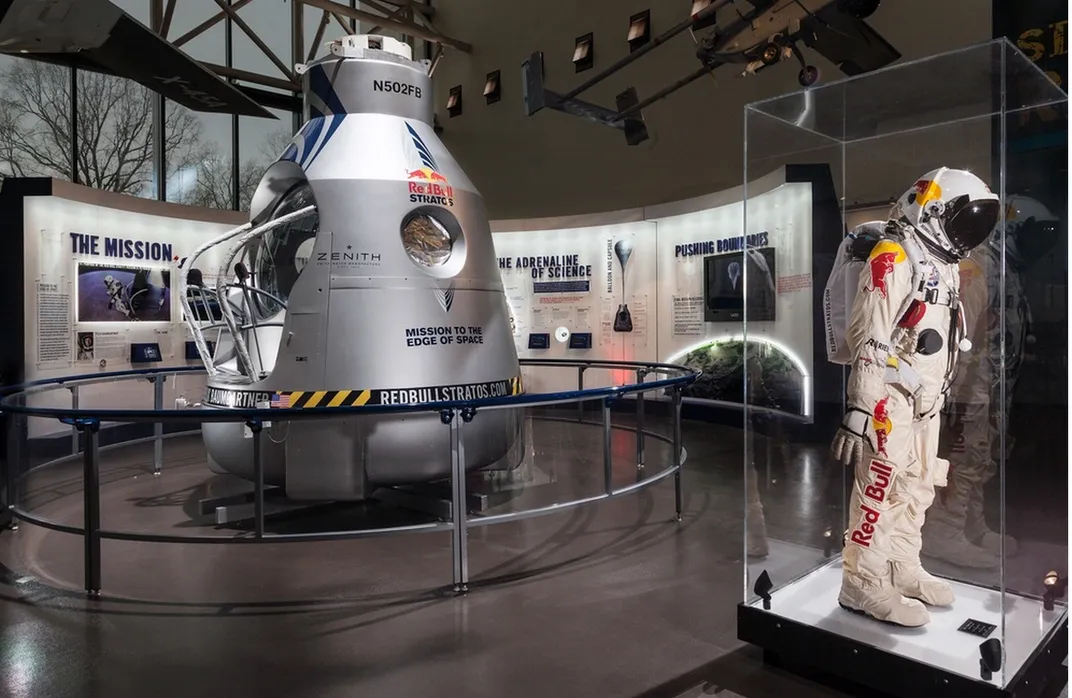Felix Baumgartner’s Spacesuit From His Death-Defying Stratospheric Jump Joins the Smithsonian Collections
The pressurized suit, parachute and the balloon gondola that allowed Baumgartner to break records goes on view at the Air and Space Museum
/https://tf-cmsv2-smithsonianmag-media.s3.amazonaws.com/filer/8e/f3/8ef3b51e-007d-4a39-b22b-87d129093176/redbull1.jpg)
Felix Baumgartner had leapt off some of the world’s tallest buildings. But while training for the Red Bull Stratos mission—a feat that would take him 24 miles above Rosewell, New Mexico, and quite literally to the ends of the Earth—he almost changed his mind. It wasn’t a fear of heights that nearly caused the daredevil Austrian to cancel the death-defying, stratospheric BASE jumping stunt watched live by over eight million people around the world. It was his pressure suit.
“The suit makes you feel very uncomfortable,” says Baumgartner. “It’s not second nature. It’s like breathing through a pillow the whole day. And I had to spend hours in the suit without being connected to the outside world. It was like being in prison.”
A psychologist eventually taught the claustrophobic Baumgartner some mental tricks to embrace the suit’s confines. “He told me, ‘You have to make sure it's like your best friend,’” he says. And sure enough, on October 14, 2012, Baumgartner wore the bulky white shell with seeming ease as he plummeted from the edge of space to Earth, breaking multiple freefall records and providing researchers with valuable scientific data tracking the impact of extreme acceleration and de-acceleration on the human body
Baumgartner’s pressure suit—a state-of-the-art, custom-designed garment that can withstand the speed of sound—is now a part of the Air and Space Museum’s permanent collections. It will be showcased alongside the balloon gondola and parachute he used to safely ascend the atmosphere's cusp in the temporary exhibit “Red Bull Stratos: Mission to the Edge of Space,” which will run from April 2 until May 26. Eventually, the objects will go on permanent display at the museum’s Steven F. Udvar-Hazy Center in Chantilly, Virginia.
“We require a great deal of careful thought when we bring objects into our museum,” says Tom Crouch, senior curator of aeronautics. “What objects represent technical breakthroughs? Which objects were part of important historic events, or captured the public imagination? The capsule, suit and parachute certainly meet those criteria, and then some.”
Baumgartner became the first human to break the speed of sound in free-fall, and he also set new and impossibly high standards for future thrill seekers striving to best the mission’s height and distance. But according to scientists and engineers involved with the project, its value doesn’t lie solely in its shock value. With the right equipment and training, a human being can safely accelerate through the sound barrier. This knowledge, says Crouch, “promises to be critically important in saving the lives of future military aviators, not to mention ticketholders in the coming generations of commercial or passenger flights that we hear so much about.”
“Look at it this way,” he adds. “A great deal of thought has been given over the past decade to getting paying customers into space. Far less thought has been given to how you get them home in the event of an emergency.”
With the advent of commercial spaceflight companies like Virgin Galactic, mankind seems destined to eventually reach—and even exceed—Baumgartner's heights. But what's next for the pioneering basejumper himself? Baumgartner says for his next post, he's hoping to become a public servant. Until then, he'll soon be taking another dramatic leap—a figurative one, that is—to a new extreme sport: racecar driving. After a lifetime of soaring through the skies, the aerial stuntman will now stick to terra firma by joining the Audi race experience team in the Nürburgring-Nordschleife, an annual endurance event in central Germany.
"They asked me because they know I deliver if the heat is on," says Baumgartner, who has no background as a racecar driver but is "working on improving his skills" in time for the swiftly-approaching June date.
Amidst his new challenges, Baumgartner savors the knowledge that he will never have to don the dreaded pressure suit again; despite repeated attempts, he says, it "never became his friend." He's glad, he says, that it's now in a museum...and no longer on his body. "To see it right here, from the outside, it feels much more comfortable," he jokes.

/https://tf-cmsv2-smithsonianmag-media.s3.amazonaws.com/accounts/headshot/Fawcett-Bio.jpg)


/https://tf-cmsv2-smithsonianmag-media.s3.amazonaws.com/accounts/headshot/Fawcett-Bio.jpg)